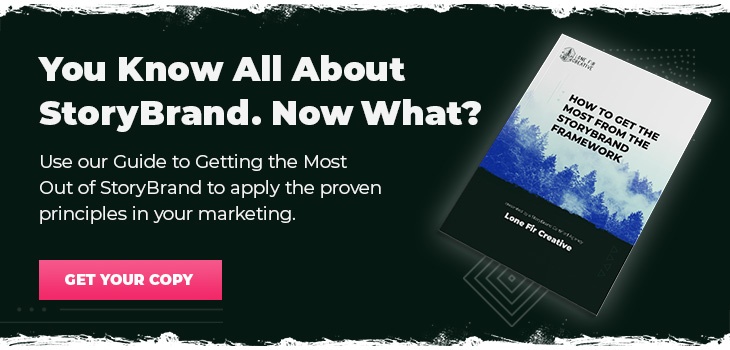We lost half of our agency income in the winter of 2018. While clients left for a variety of reasons, losses on that scale are the kind of thing that can sink a marketing agency. We had a serious problem, and something needed to change.
[This article has been updated to reflect how StoryBrand has continued to help us grow since its initial publication in 2019]
📺 Check out this interview where I talk to our Director of Sales and Marketing about how we bounced back.👇
It was during this period of turmoil that our agency learned about StoryBrand. Developed by Nashville-based author, Donald Miller, the StoryBrand Framework is a brand messaging framework based on a hero’s journey. It uses a story-driven approach to help businesses simplify their messaging. It's a communication method that places the customer at the center of everything.
If you haven't already, take a couple days to read through Building a StoryBrand.
"When we position our customer as the hero and ourselves as their guide, we will be recognized as a sought-after character to help them along their journey. In other words, your audience is Luke Skywalker. You get to be Yoda. It’s a small but powerful shift. This honors the journey and struggles of our audience, and it allows us to provide the product or service they need to succeed." - Don Miller
Becoming StoryBrand Guides helped our marketing agency do several things:
- Present a clear message to prospective customers
- Overhaul our approach to working with clients
- Opened up an entirely new revenue stream through StoryBrand referrals
We landed our first StoryBrand client within 30 days of completing the certification. We added roughly one to two monthly retainer clients each month over the following six months.
What’s the StoryBrand Framework?
Pick any popular story, and you’ll find a hero at the center of the action. The StoryBrand Framework takes that structure and applies it to your brand: the hero is not the business. It's the customer.
When you imagine a hero, there’s always a problem that they have to overcome to succeed. Along the way, they meet someone who’s going to help them overcome that problem by guiding them through a process. This guide (in the StoryBrand Framework, this is the business), offers a process that allows the hero to find success. If they choose to ignore the process, they face failure and repeat the cycle over again until they win. This is Yoda helping Luke. It’s Gandalf guiding Frodo. It's how businesses should be positioning themselves to help their customers succeed.
Using this framework, it becomes much simpler for businesses to talk about their offerings as the problems they solve for customers, in a way that's easy to understand. Brands are the guides that help their hero-customers win. This clarity of purpose allows clients, prospects and anyone reading your marketing messaging to understand precisely what you do and how it helps them move forward in their journey.
Agency Life Before Becoming a StoryBrand Certified Guide
Our agency had a hard but essential period of self-assessment. Becoming a StoryBrand Certified Guide wouldn’t have solved our problems if we didn't have a clear understanding of what problems we had. When we reflected on our project and client intake processes, some troubling patterns stood out.
How We Used to Work With Clients
Digital ‘Yes’ Men
While doing whatever you're asked might seem like really good customer service, we quickly found out it's not. When clients came to us with a need, we’d say yes to whatever they asked. We weren’t guiding them through a process that made them better or was proven to work; we were digital ‘yes’ men.
Our company's mission statement is "Do what's in the best interest of our people and our clients — always." Saying yes to things that we know won't work isn't doing what's in the best interest of our clients, it's just us collecting a paycheck.
Moreover, this “do whatever you’re asked” approach didn't engender respect or trust in the quality of service we were offering, and it wasn’t helping our clients accomplish their goals.
We Routinely Undermined Our Process
Another issue that came from saying yes to every project and budget that came our way was that it undermined the credibility of our process. We would morph and change and flex to whatever the client wanted. If a client didn’t want to do a customer persona (a critical element of our previous process), we’d drop it. This had a ripple effect. We would go to build a new website, write copy for an email campaign, or create a sales funnel, and we'd lack the context to craft a clear and compelling message. We regularly undermined our process in the pursuit of making clients happy in the near term. In the end, this only weakened our effectiveness and didn’t build long-term relationships with clients where they had confidence in us.
Customers Didn’t Understand What We Did
It was hard for us to communicate what we offered, and as a result, it was hard for clients to understand what we did. We even had trouble explaining our agency to family and friends, which should have been a red flag. This lack of clarity was part of why customers felt like they could ask us for anything, and why we were willing to go along with it. We would introduce ourselves as a marketing agency and then expect clients and prospects to know what we mean, we operated on ‘assumption.’ Which ultimately was a killer for us.
The underlying problem was that we assumed (there’s that word again...assume) our customers knew exactly how to talk about their business. We trusted everything they said without assessing the clarity and quality of their message. In part, this was because they were experts in their industry, right? They were supposed to know their product and their market, and we assumed they knew their message.
Oftentimes entrepreneurs and business owners have been so close to their business for so many years that they suffer from the “curse of knowledge,” they’ve been drinking their own Kool-Aid for too long. This isn’t a bad thing, it just often takes an outside filter to uncover how to clarify your brand messaging so that more prospects will find you and know you are the solution to your problems.
We needed to be more explicit about what we offered and why it would add value to their lives. (Can you imagine Yoda saying, “Luke, the force MIGHT help you defeat Darth Vader, but if you just want to swing a lightsaber around for a while, we can do that instead”?) And here’s the thing, they were coming to us because they wanted to hire a marketing agency. They knew they had a problem and needed a solution. Doing a deep dive into a company’s core message is standard marketing practice, and we were shying away from a critical component of our job.
In retrospect, we should have jumped in early and fixed our client’s messaging up front. We should have taken them through a brand messaging workshop, even if they didn’t think they needed it. Wavering on this part of our process hampered our ability to add value, and ultimately lost our agency tens of thousands of dollars.
Agency Life After Becoming a StoryBrand Guide
Attending the StoryBrand Certified Guide training transformed our agency. We spent several days walking through the StoryBrand Framework. We practiced and worked with other attendees to ingrain the principles of StoryBrand deep into our practices. It takes repetition to improve a skill, and the Guide training gave us the practical tools we needed, but the rest was up to us.
In going through that training, we had to take our agency through the process of creating a BrandScript (StoryBrand’s version of a messaging framework.) This forced us to clearly define who we wanted Lone Fir Creative to be in the lives of our customers. When we developed a clear message, we were able to refine our sales and marketing efforts to communicate with customers clearly. Today, that is that we provide methodical marketing for brands with ambitious goals.
We were still implementing the same elements of a sound marketing strategy (web design and development, sales funnels, email marketing, content creation, sales letters, search engine optimization, etc.). But now, we were an agency that knew who we wanted to be and what we had to offer.
When you’re an agency or business that knows who you are, you also know who you want to work with and how you can help them. If you don’t know who you are, then you’re at the mercy of whoever is willing to break out the checkbook. There’s no process, no clarity, no guiding, and rarely any value provided to the customer at the end of the project. Companies that try to be all things to all people will land clients. But without a clear message and process in place, they will always churn customers at a higher rate and deliver significantly less value.
Practically, this means that not everyone who seeks services from Lone Fir Creative is the right fit as a customer. It’s hard to say ‘no’ to opportunities that we would have said ‘yes’ to in the past (and that would pay good money too!) But now we know from experience that it’s not worth compromising your identity and process as a company. It’s also grown our ability to provide value to clients, it’s not helpful to clients to sign them up knowing that you might be wasting their time since you aren’t the right fit, but “you’ll try.” That only hurts your brand in the long run (and the client's success).
Incorporating the StoryBrand Messaging Framework Into Everything
The StoryBrand Messaging Framework positions your customer as a hero. They're a hero who is trying to solve a multi-layered problem (external, internal, philosophical). Your business is the guide who uses their authority and expertise to help the customer (hero) overcome their challenges and find success. The plan that you offer as the guide is the vehicle that guides the hero to victory.
After going through the StoryBrand Certified Guide Program, our agency ditched marketing personas in favor of this messaging framework. Through rigorous self-application, we're confident that any client who starts with building a BrandScript for their business and its products and/or services is going to find success.
The power of a well-developed messaging framework is that it can be applied to everything:
- website design
- content creation
- landing page design + copy
- paid advertising creation + copy
- email sequences
- marketing emails
- sales funnels
- brand positioning
- calls to action
The list goes on. The StoryBrand Framework doesn't just apply to copywriting. It serves as a filter for all your marketing and sales efforts.
If the old approach was all about the business (how long it’s been around and why it’s the best), then the new way is entirely about the customer, the challenges they’re trying to solve, and how the business is the right fit to guide them to a solution. This requires a complete message rework, which makes the BrandScript our most crucial tool.
👉 Also related: How to Get the Most Out of the StoryBrand Framework
Changing How We Work With Clients
Post-StoryBrand training, our agency revamped our approach to client work. We set up a standardized onboarding experience that is the same for every client — no exceptions. We had a clear sense of the value we had to offer and how we could help solve customer’s marketing and sales problems. If they weren’t trying to solve the problems we had solutions for, now that was clear. This required our agency to set some foundational practices, and then create a standardized onboarding experience and an ongoing approach to help obtain the client's objectives both near term and in the future.
Set Foundational Practices and Values
Set Standard Services
We still develop marketing plans and marketing materials, but our packages and processes are established and focused on delivering repeatable results. Yes, we’re flexible to the unique needs of clients, but only within our framework. We’re not chasing random projects that aren’t within our core skillset where it’s unlikely we’d add real value anyway.
Require a BrandScript/Messaging Framework
Every one of Lone Fir Creative's clients need a BrandScript and messaging framework. In the past, we would let customers decide if they wanted this or not. The results weren’t great, and we learned our lesson. A messaging framework is essential to creating marketing materials that are effective and add value over time.
Our Onboarding Process for Every Client
Kickoff Call
Our kickoff calls are focused on both parties getting to know each other, walking through the project timelines and setting deliverables and expectations. We always end with a clear presentation on the StoryBrand Framework, so everyone understands what the process requires. We work to manage expectations since clients often fear (understandably so) that they might be getting into something that won’t deliver. We get it — it's unfamiliar. We need to do our job as guides and remove fear and confusion.
Framework/Messaging Workshop
Our next step is to have a two hour messaging workshop to walk through the actual StoryBrand Framework. It's a question intensive session that allows us to get to the core of what a business is all about:
- Who your customers want to become after using your product or service
- The problems your customers face
- How your business can be the guide that leads them to victory
We then refine that information through the filter of the framework. Some businesses have their messaging already figured out and well-documented. For those clients, our team takes some time to understand the answers to the questions above before moving on to the project.
Focus on Appropriate Deliverables
Once we’ve got our StoryBrand messaging framework set, we are free to focus on the deliverables that matter most to your company. This could be client-driven, if they’ve got a specific strategy they need help executing, or it could be working through a digital marketing roadmap in order to build a strategy to help the client exceed their marketing and sales goals. The bottom line is that it all depends on what we learn about you, your business goals and objectives, and what next steps you need to take to grow and meet your ambitious goals.
Hiring a Certified StoryBrand Guide
Maybe you're at the point of considering next steps or looking to hire a StoryBrand Guide. When hiring a StoryBrand Certified Guide, there are a few things that business owners should consider:
Do they have a proven track record? While the StoryBrand Guide Certification is a powerful thing, it’s still important to make sure that they have helped people succeed in the past. Pay close attention to testimonials, variety of clients and overall level of experience/portfolio of work. Do they practice what they preach? The website is almost always a dead give away. Does the Guide you're considering have a branded website and set of service offerings that reflect the values and clarity of StoryBrand? If not, this should be a red flag about the quality of this person’s guidance and process.
Do they have a team that will help you succeed? Since I first wrote this article, StoryBrand has introduced the StoryBrand Agency Certification, which means there are entire agencies out there that are experienced in capitalizing on the StoryBrand framework for the success of your business.
There is a big difference between working with a solo freelancer (who can only take on so much work) and working with a team. An agency or team practicing StoryBrand Certified Guide principles is going to bring an entirely different level of support, insight and guidance to help your business succeed. It's one brain versus many when it comes to solving your problem.
👉 Want to see some real applications of StoryBrand? Check out these StoryBrand Website Examples We Love









